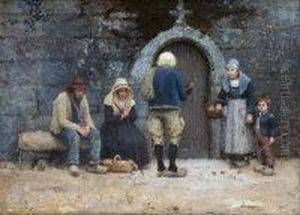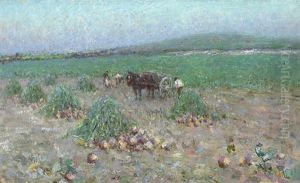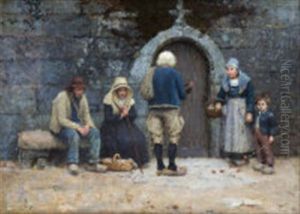Nathaniel Hill Paintings
Nathaniel Hone the Younger, often known simply as Nathaniel Hone, was an Irish painter born on October 10, 1861, in Dublin, Ireland. He was named after his great-grand-uncle, Nathaniel Hone the Elder, who was a renowned portrait and miniature painter in the 18th century. Nathaniel Hill, though less widely known than his namesake, was a significant artist in his own right and contributed to the Irish and British art scenes of the late 19th and early 20th centuries.
Hill's artistic journey began at the Dublin Metropolitan School of Art, where he honed his skills and developed a foundation in the arts. He later moved to Antwerp to further his education, studying under the influential figure Charles Verlat at the Royal Academy of Fine Arts. This European training was typical for many Irish artists of the time, who sought to expand their artistic horizons beyond the British Isles. Hill's work during this period was marked by a strong academic foundation, with an emphasis on figure painting.
After his time in Antwerp, Hill ventured to Brittany, which was a popular destination for artists. The picturesque landscapes and rural life of Brittany provided ample inspiration for Hill and his contemporaries, who were drawn to the region's rustic charm and the opportunity to engage with plein air painting, a practice that was becoming increasingly popular at the end of the 19th century.
Hill's work often depicted the rural landscapes and the people of Ireland and Brittany, capturing the essence of the locales with a sensitive and nuanced approach. He was skilled in both oil painting and watercolor, and his work often reflected a naturalistic style, influenced by the plein air tradition and his academic training.
During his career, Hill exhibited his work extensively. He was associated with the Royal Hibernian Academy (RHA) in Dublin and became a frequent exhibitor there, as well as at the Royal Academy in London. Despite living through a period of significant political and social change in Ireland, Hill's work remained primarily focused on landscape and genre scenes rather than overt political or social commentary.
Nathaniel Hill passed away in 1934, leaving behind a body of work that, while perhaps not as widely recognized as that of some of his contemporaries, provides valuable insight into the artistic movements and styles that flourished in Ireland and Brittany during his lifetime. His paintings are a testament to his technical skill and his ability to capture the subtleties of the environments and people he painted.


